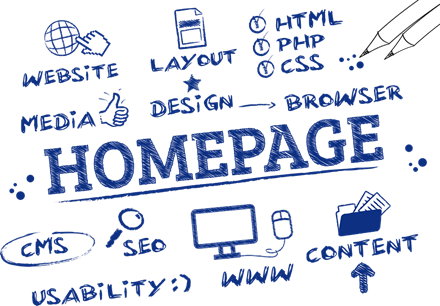Your homepage serves an important purpose as it is the first impression many people will have of your site. How you organize and structure your homepage has a direct impact on the experience new visitors have with your brand. Make sure your website is sending the right message with these seven tips for optimizing your homepage for conversions.
Start with a Goal
What’s the purpose of your homepage? What specific action do you want people to take? Should they sign up for a newsletter? Click a link for more information? Browse your resources and reports?
We generally recommend no more than 5 to 7 top-level menu items on your homepage. However, including content for all of your top-level navigation on the homepage itself will likely lead to confusion and indecision. Instead, narrow it down to the top 3 actions you want people to take, and design your homepage accordingly.
 Give People a Path
Give People a Path
People will come to your website in various stages of the buying cycle. Some people may be looking for information in order to research, others may be ready to comparison shop, and still others have arrived on your site with the intent to purchase.
Make sure that no matter where people are in the buying cycle, they can easily navigate to the page they need from your homepage. Your UI should be intuitive, and it should be clear what will happen when a link is clicked or a button is tapped.
Organize for Clarity
Taking it a step further, you should also organize your calls to action in a logical fashion. Don’t put buying guides in the same section as general information sheets. Don’t crowd your newsletter signup form and your contact form into the same space.
Organize your site so there is a logical hierarchy for actions and so that the most important sections of your website also have their own sections on the homepage. Think of your homepage like a series of funnels – ensure that items in related conversion funnels are placed close together.
Don’t Clutter the Issue
It can be tempting to put a lot of content on the homepage in order to get as much information as possible in front of your visitors right away, but don’t give in. Instead, think of your homepage like a table of contents or a directory that provides users with a brief overview of the information they might be looking for.
Structured this way, you’ll avoid overwhelming your website visitors and can get more people to stay on your website and engage.
Put Your Best Offer Forward
If there is a particular offer that you want to be sure visitors don’t miss, highlight it on both your homepage and any pages related to that offer. A good way to do this is with a small banner or bar at the top of your homepage.
If you do decide to highlight a particular offer in this way, be sure that it is relevant for a large portion of your audience. For example, you might highlight a limited-time free shipping offer for an ecommerce store, or a free event or webinar for a B2B company.
Get Social Proof Front & Center
People want to know how well your products or services will work to solve their problems. There’s no better way to demonstrate your effectiveness and communicate brand value than by using the words and experiences of current customers.
Presenting social proof through reviews, testimonials, or case study summaries can be an effective way to build visitor trust and get them to consider buying from you. Experiment with including social proof on your homepage near relevant sections where users might go to know more about your offerings.
Make it Easy to Convert
Lastly, make it as easy as possible for users to take the next step. Do they need to click a link? Fill out a form? Make a phone call? Whatever action you want your visitors to take, make it easy for them to do so on desktop and mobile devices.
Clear call-to-action buttons and direct, actionable wording will guide people towards a conversion.
NEED HELP WITH YOUR HOMEPAGE?
Contact us! Our experts will give you a full website review complete with recommendations on how you can boost conversions on your homepage as well as the content pages of your site.

